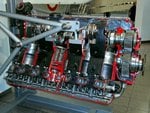What lay behind the Germans being the only country to develope the inverted V12. The only thing I can see that the DB series and Junkers Jumo designs provide different from upright V12s is a lower thrust line. And the thrust line can be changed easier by different crank gearbox designs.
I can't see that it doesn't improve pilot vision, the crank sump is still in the way. It seems to me the inverted design introduced difficult oil scavaging problems.
Was their desire to develope motor cannons that fired thru the propelle hubr behind it ?
Why, why, why ?
I can't see that it doesn't improve pilot vision, the crank sump is still in the way. It seems to me the inverted design introduced difficult oil scavaging problems.
Was their desire to develope motor cannons that fired thru the propelle hubr behind it ?
Why, why, why ?

